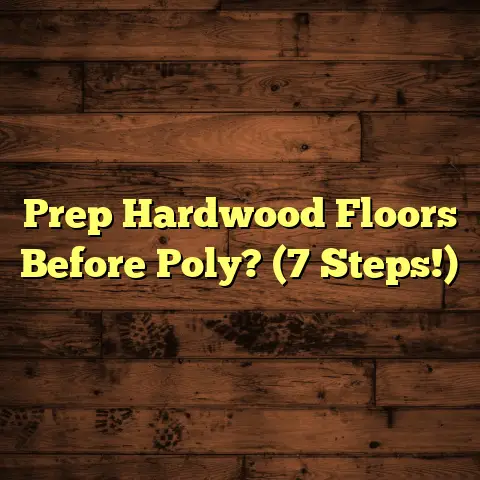Bamboo Flooring: How Durable Is It? (1 Hidden Weakness!)
(1 Hidden Weakness!)
Imagine this: It’s a typical Saturday morning. The kids are building a fort in the living room, their laughter echoing throughout the house. Your partner is in the kitchen, whipping up pancakes. The dog is happily chewing on his favorite toy near the back door.
This is home. And underneath all that beautiful chaos is your flooring. It’s the silent foundation upon which family life unfolds.
As a flooring contractor with years of experience, I’ve seen families search for that perfect balance: beauty, durability, and something that can stand up to the daily grind. Bamboo flooring often enters the conversation, and for good reason. It’s stylish, eco-friendly, and often more affordable than traditional hardwood.
But how durable is it, really? And are there any hidden gotchas you should know about before taking the plunge? Let’s dive in!
Section 1: Understanding Bamboo Flooring
So, what exactly is bamboo flooring?
It’s made from bamboo, a fast-growing grass (yes, grass!) that’s harvested and processed into flooring planks. Think of it like this: instead of cutting down a tree that takes decades to mature, bamboo can be harvested in just a few years, making it a more sustainable choice.
Why the Buzz Around Bamboo?
Bamboo has exploded in popularity, and families are particularly drawn to it for a few key reasons:
- Eco-Friendliness: As I mentioned, it’s a renewable resource.
- Style: It offers a sleek, modern look that complements many décor styles.
- Cost: It’s often more budget-friendly than hardwood.
Decoding the Different Types
Now, here’s where it gets a little more technical. Not all bamboo flooring is created equal. You’ll typically encounter three main types:
- Solid Bamboo: These planks are made from solid pieces of bamboo.
- Engineered Bamboo: Similar to engineered hardwood, this type has a bamboo veneer on top of a plywood or fiberboard core.
- Strand-Woven Bamboo: This is the densest and often the most durable type. It’s made by shredding bamboo stalks into strands, weaving them together, and compressing them under high pressure.
Section 2: Durability of Bamboo Flooring
Let’s get down to the nitty-gritty: how tough is this stuff?
Measuring Up: The Janka Hardness Test
One of the most common ways to measure flooring hardness is the Janka hardness test. This test measures the force required to embed a steel ball into the wood. The higher the number, the harder the material.
Here’s a quick comparison:
| Wood Type | Janka Hardness Rating |
|---|---|
| Red Oak | 1290 |
| Maple | 1450 |
| Strand-Woven Bamboo | 3000+ |
| Traditional Bamboo | 1000-1500 |
| Brazilian Cherry | 2350 |
As you can see, strand-woven bamboo can be significantly harder than many traditional hardwoods! Standard bamboo is still on par with, or slightly above, the hardness of Red Oak. This means that with proper care, it can withstand a good amount of foot traffic, scratches, and dents.
Natural Perks: Moisture Resistance and More
Bamboo also has some inherent properties that contribute to its durability:
- Moisture Resistance: Bamboo is naturally more resistant to moisture than some hardwoods, making it a good choice for kitchens and bathrooms (though you still need to be careful!).
- Anti-Microbial Properties: Bamboo contains a natural anti-microbial agent called “bamboo kun,” which can help inhibit the growth of bacteria and mold.
The Long Haul: Lifespan Expectations
With proper installation and maintenance, a good quality bamboo floor can last for 20-50 years. I’ve seen it hold up beautifully in busy family homes, even with kids and pets.
Section 3: The Hidden Weakness of Bamboo Flooring
Okay, here’s the part you’ve been waiting for: the hidden weakness. While bamboo is generally durable, it’s not impervious to water damage.
Water: Bamboo’s Kryptonite
Excessive exposure to water can cause bamboo flooring to:
- Swell: The planks can expand and buckle.
- Warp: The flooring can become uneven and distorted.
- Develop Mold/Mildew: This can lead to health problems and further damage the floor.
Real-World Scenarios
Think about these common family situations:
- Spills: Kids are notorious for spilling drinks. If spills aren’t cleaned up promptly, the water can seep into the bamboo.
- Humidity: High humidity levels, especially in bathrooms or basements, can cause the bamboo to absorb moisture from the air.
- Improper Cleaning: Using excessive water or harsh chemicals when cleaning can damage the floor.
Why This Matters to Families
For families with young children or pets, the risk of water damage is even greater. Accidents happen, and it’s crucial to be proactive in protecting your bamboo flooring.
Section 4: Real-Life Experiences and Case Studies
Let’s hear from some families who’ve lived with bamboo flooring.
The Good: A Family’s Success Story
I recently spoke with a family in Denver, Colorado, who installed strand-woven bamboo flooring in their kitchen. They have two young children and a dog. They told me that they chose bamboo because they wanted a durable, eco-friendly option that could stand up to the demands of their busy household.
They’ve been thrilled with their choice. They said the flooring is easy to clean, resists scratches from the dog’s nails, and still looks beautiful after several years. They’ve been diligent about cleaning up spills immediately and using mats in high-traffic areas, which has helped to keep their floor in great condition.
The Not-So-Good: A Water Damage Nightmare
On the other hand, I worked with a family who had a less positive experience. They installed solid bamboo flooring in their basement. Unfortunately, they had a minor flood due to a burst pipe. They didn’t realize the extent of the water damage until it was too late. The bamboo planks swelled and warped, and they had to replace a significant portion of the flooring.
This case highlights the importance of addressing water issues promptly and choosing the right type of bamboo for moisture-prone areas. Engineered bamboo is typically a better choice for basements because it’s more dimensionally stable.
Section 5: Maintenance and Care for Bamboo Flooring
So, how can you protect your bamboo flooring from its hidden weakness and keep it looking its best?
Best Practices
Here are some essential maintenance tips:
- Clean Up Spills Immediately: Don’t let water sit on the surface.
- Use Mats and Rugs: Place mats at entrances and in high-traffic areas to protect the floor from dirt and moisture.
- Maintain Proper Humidity Levels: Use a dehumidifier in damp areas, and ensure good ventilation.
- Use the Right Cleaning Products: Avoid harsh chemicals and excessive water. I recommend using a pH-neutral cleaner specifically designed for bamboo flooring.
- Avoid Steam Mops: Steam can force moisture into the seams and damage the floor.
- Regularly Inspect for Leaks: Check under sinks, around appliances, and near windows for any signs of water damage.
Cleaning Methods
For regular cleaning, I recommend sweeping or vacuuming the floor to remove dirt and debris. Then, use a damp (not wet!) mop with a pH-neutral cleaner.
Humidity Control
Maintaining a consistent humidity level is crucial. The ideal range is typically between 30% and 50%. Use a hygrometer to monitor the humidity in your home.
Long-Term Care
Over time, you may need to refinish your bamboo flooring to restore its luster. The frequency of refinishing will depend on the amount of wear and tear the floor receives.
Section 6: Conclusion
So, is bamboo flooring durable? The answer is a resounding yes, with a caveat. It’s a tough and beautiful option that can withstand the demands of family life, but it’s essential to be aware of its susceptibility to water damage.
Making the Right Choice
Choosing the right flooring is a big decision. It’s about more than just aesthetics; it’s about creating a comfortable, safe, and durable living environment for your family.
By understanding the characteristics of bamboo flooring, including its strengths and weaknesses, you can make an informed decision that enhances your family’s home for years to come.
A Final Thought
With proper care and maintenance, bamboo flooring can be a fantastic choice for families who value sustainability, style, and durability. Just remember to keep an eye out for that hidden weakness and take steps to protect your investment.




